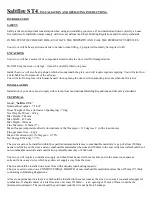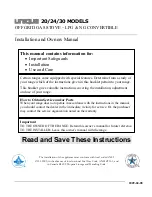
8
Intrepid 1640 Woodburning Stove
30000830
ST276
CSA approved wall
pass-through
12/99
Fig. 13
CSA approved Wall Pass-through.
24 ga.Sheet
Steel Support
24 ga. Sheet
Steel Support
(one side only)
Min. 18”
(460mm)
Chimney clearance to sheet steel
supports and combustibles
2” (51mm)
Min.
Chimney Flue
Chimney
Connector
Masonry Chimney
constructed to CAN/CSA-
B365
Min. 18”
(460mm)
ST276
ST273
nfpa
factory built insulated
chimney section
12/99
Fig. 10
Wall Pass-through using factory-built insulated
chimney section.
Min. 9”
(230mm)
Air Space
Min. 9”
230mm
Chimney Flue
Sheet Steel
Supports
Min. 2”
(51mm)
Non-soluble refrac-
tory cement
Solid insulated,
listed factory-
built chimney
length set flush
with flue
Chimney
Connector
Masonry
Chimney
constructed to
NFPA 211
24 ga.Sheet
Steel Sup-
ports
ST273
ST275
wall with
ventilated
steel thimble
Fig. 12
Wall Pass-through with ventilated steel thimble.
24 ga. Sheet
Steel Supports
24 ga. Sheet
Steel Supports
2” (51mm) Min.
Chimney clearance to sheet steel
supports and combustibles
2” (51mm)
Min.
Chimney Flue
2” (51mm) Min.
air space
Prefab Chim-
ney
Section
Prefab
Chimney
Section
Chimney Con-
nector
Masonry Chimney construct-
ed to NFPA 211
ST275
ST274
single wall
w/ventilated thimble
12/99
Fig. 11
Wall Pass-through using single wall chimney
connector with a ventilated steel thimble.
Min. 6”
(152mm)
Chimney clearance to sheet steel
supports and combustibles
2” (51mm) Min.
Glass Fiber
Insulation
Chimney Connector
Chimney Flue
Steel Thimble
with two 1”
(25mm) Ventilated
Channels
Masonry Chimney construct-
ed to NFPA 211
24 ga.Sheet
Steel Supports
ST274
Canadian Requirements:
In Canada, the Canadian Standards Association has
established specific guidelines regarding wall pass-
though design. Figure 13 shows one approved method
in which all combustible material in the wall is cut away
to provide the required 18” (457mm) clearance around
the connector. The resulting space must remain empty.
A flush-mounted sheet metal cover may be used on one
side only. If covers must be used on both sides, each
cover must be mounted on noncombustible spacers at
least 1” (25mm) clear of the wall. Your local dealer or
your local building inspector can provide details of other
approved methods of passing a chimney connector
through a combustible wall.
In Canada, this type of installation must conform to
CAN/CSA-B365, Installation Code for Solid Fuel Burn-
ing Appliances and Equipment.
Floor Protection
A tremendous amount of heat radiates from the bottom
plate of an Intrepid II, and the floor beneath requires
two kinds of special protection.
Heat protection is provided by a Vermont Castings Bot-
tom Heat Shield, part #0307.
Spark and ember protection is provided by a floor pro-
tector, which may be any noncombustible material.
For a new hearth, we recommend a noncombustible
floor protector such as 1/4” non-asbestos mineral board
or its equivalent, or 24 gauge sheet metal. If carpeting
is present, it must be removed before installation of the
floor protector. The floor protector may be covered with
a noncombustible decorative material if desired. When
using brick, tile, or stone, individual pieces must be
mortared so sparks cannot fall through.
When the optional 3” (75mm) short legs are used, the
bottom heat shield must be used.
Most installations will require that the bottom heat
shield be attached. Only when the stove is placed
on a completely noncombustible surface, such as
unpainted concrete over earth, may it be used with-
out the bottom heat shield.
Even with the bottom heat shield installed, you must
also use a floor protector.
In the United States,
the floor protector required under
the stove must extend at least 16” from the front of the
stove - not from the ashlip - ( ‘E’ in Fig. 14), and at least
6” from the sides and rear (‘D’, Fig. 14).
To meet the requirement in the United States, a floor
protector must be at least 34” wide and 40” deep.
f i r e - p a r t s . c o m









































